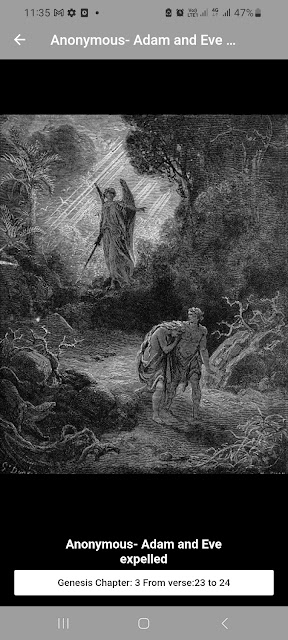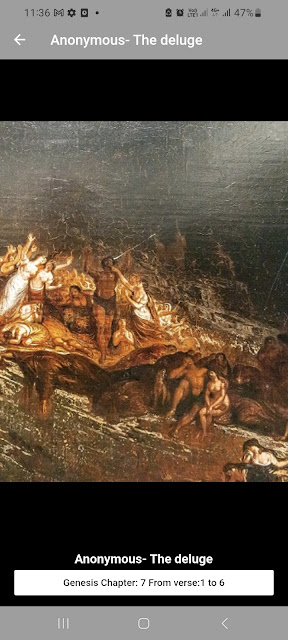If you are a Catholic Religious Art fan, then our app is for you. We have an Android and ios version that encompasses almost 1,000 original works, starting in the Renaissance period to more recent times.
a) Adam and Eve expelled Gen 3: 23-24
This painting shows the story of Adam and Eve being expelled from the Garden of Eden and is a central part of the Abrahamic religions, particularly Christianity, Judaism, and Islam. It is told in the first book of the Bible, Genesis, and is considered a foundational story for these religions.
According to the story, Adam and Eve were created by God and placed in the Garden of Eden, a perfect and idyllic place. They were allowed to live in this paradise and were free to eat from any tree in the garden, except the Tree of the Knowledge of Good and Evil. However, they were tempted by the serpent to eat from the forbidden tree, and they did so.
This painting shows the story of Adam and Eve being expelled from the Garden of Eden and is a central part of the Abrahamic religions, particularly Christianity, Judaism, and Islam. It is told in the first book of the Bible, Genesis, and is considered a foundational story for these religions.
According to the story, Adam and Eve were created by God and placed in the Garden of Eden, a perfect and idyllic place. They were allowed to live in this paradise and were free to eat from any tree in the garden, except the Tree of the Knowledge of Good and Evil. However, they were tempted by the serpent to eat from the forbidden tree, and they did so.
As a result of their disobedience, God expelled them and they were forced to live in a world that was much different from the paradise they had known before. They had to work hard to survive and raise their children in a world filled with hardship, suffering, and death.
The story is often seen as a story of the origin of sin and its consequences. It is also seen as a story of the beginning of human history, with the fall of Adam and Eve representing the loss of innocence and the beginning of the human struggle.
Overall, the story is an important religious story that continues to be interpreted and reinterpreted in various ways by different religious traditions.
b) The deluge Gen 7:1-6
As a result of their disobedience, God expelled them and they were forced to live in a world that was much different from the paradise they had known before. They had to work hard to survive and raise their children in a world filled with hardship, suffering, and death.
The story is often seen as a story of the origin of sin and its consequences. It is also seen as a story of the beginning of human history, with the fall of Adam and Eve representing the loss of innocence and the beginning of the human struggle.
Overall, the story is an important religious story that continues to be interpreted and reinterpreted in various ways by different religious traditions.
b) The deluge Gen 7:1-6
The story of the Deluge, also known as the Flood, is a biblical account found in the book of Genesis, chapter 7, verses 1-6. The story describes how God saw the earth was corrupt and filled with violence and decided to cleanse it with a flood. God chose Noah, a righteous man, to build an ark and gather food for himself, his family, and the animals. The flood lasted for forty days and forty nights, and all living creatures except those on the ark perished. After the flood waters receded, God made a covenant with Noah, promising never to destroy the earth with a flood again. The story is often interpreted as a symbol of divine punishment and redemption, reminding us of the consequences of sin and the mercy and grace of God.
c) Moses descends Exodus 34: 29-35
c) Moses descends Exodus 34: 29-35
This painting depicts the story of Moses descending from the mountain and is found in the book of Exodus, chapter 34, verses 29-35. In this story, Moses had gone up to Mount Sinai to receive the Ten Commandments from God. When he came down from the mountain, his face was shining with a radiant glow because he had been speaking directly with God.
The people of Israel saw the radiant glow on Moses' face and were afraid to approach him, so he placed a veil over his face to hide the radiance. However, when he spoke with the people, he would take off the veil, and the radiance would shine through again.
This story is significant in the history of Judaism and is often interpreted as a symbol of the encounter between God and humanity. It is also seen as a reminder of the power and holiness of God and the importance of respecting and revering Him.
Overall, the story is an important part of the biblical narrative, providing insight into the relationship between God and His people and the nature of divine revelation.
d) The vision of Ezekiel Ezekiel 37: 1-14
This painting depicts the story of Moses descending from the mountain and is found in the book of Exodus, chapter 34, verses 29-35. In this story, Moses had gone up to Mount Sinai to receive the Ten Commandments from God. When he came down from the mountain, his face was shining with a radiant glow because he had been speaking directly with God.
The people of Israel saw the radiant glow on Moses' face and were afraid to approach him, so he placed a veil over his face to hide the radiance. However, when he spoke with the people, he would take off the veil, and the radiance would shine through again.
This story is significant in the history of Judaism and is often interpreted as a symbol of the encounter between God and humanity. It is also seen as a reminder of the power and holiness of God and the importance of respecting and revering Him.
Overall, the story is an important part of the biblical narrative, providing insight into the relationship between God and His people and the nature of divine revelation.
d) The vision of Ezekiel Ezekiel 37: 1-14
The vision of Ezekiel is a powerful and vivid prophetic vision that the prophet Ezekiel received from God. In the vision, Ezekiel found himself in a valley filled with dry bones. The Lord asked him if the bones could live again, and Ezekiel replied that only God knew.
Then the Lord commanded the bones to come together, and as Ezekiel watched, sinews, flesh, and skin covered the bones, and then the bones came to life and stood up as a great army. The Lord then told Ezekiel that these bones represented the people of Israel, who were in a state of spiritual death and had lost their hope and faith in God.
The vision was meant to be a message of hope and encouragement to the people of Israel, who were in exile in Babylon at the time. The Lord was promising them that He would restore them to their homeland, reunite them with their families, and bring them back to a state of spiritual life and health.
The vision of Ezekiel is considered one of the most powerful and significant prophetic visions in the Old Testament, and it continues to be an important part of the biblical narrative. It is often interpreted as a symbol of the power of God to restore life, hope, and faith to His people, even in the darkest and most difficult circumstances.
e) The pillar of fire Exodus 13: 20-22
Then the Lord commanded the bones to come together, and as Ezekiel watched, sinews, flesh, and skin covered the bones, and then the bones came to life and stood up as a great army. The Lord then told Ezekiel that these bones represented the people of Israel, who were in a state of spiritual death and had lost their hope and faith in God.
The vision was meant to be a message of hope and encouragement to the people of Israel, who were in exile in Babylon at the time. The Lord was promising them that He would restore them to their homeland, reunite them with their families, and bring them back to a state of spiritual life and health.
The vision of Ezekiel is considered one of the most powerful and significant prophetic visions in the Old Testament, and it continues to be an important part of the biblical narrative. It is often interpreted as a symbol of the power of God to restore life, hope, and faith to His people, even in the darkest and most difficult circumstances.
e) The pillar of fire Exodus 13: 20-22
The story describes how the Israelites were led by God during their journey through the wilderness from Egypt to the Promised Land. God led them by a pillar of fire by night and a cloud by day. The pillar of fire provided light and guidance for the Israelites during their travels and protected them from danger.
The pillar of fire is a symbol of God's presence and protection and serves as a reminder of His faithfulness to His people. It is also seen as a symbol of God's guidance and direction, reminding us that He is always with us and will lead us to safety, even in the darkest and most difficult circumstances.
Overall, the pillar of fire is an important part of the biblical narrative, providing insight into the relationship between God and His people and the nature of divine guidance and protection.
f)Jonah and the whale Jonah 2:1-10
The pillar of fire is a symbol of God's presence and protection and serves as a reminder of His faithfulness to His people. It is also seen as a symbol of God's guidance and direction, reminding us that He is always with us and will lead us to safety, even in the darkest and most difficult circumstances.
Overall, the pillar of fire is an important part of the biblical narrative, providing insight into the relationship between God and His people and the nature of divine guidance and protection.





